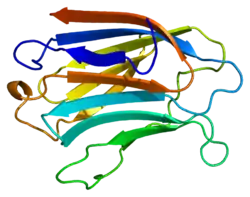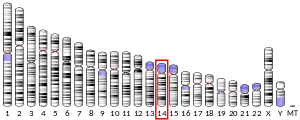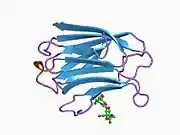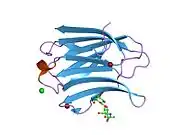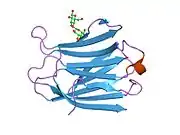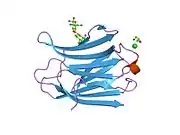Galectin-3 is a protein that in humans is encoded by the LGALS3 gene.[5][6] Galectin-3 is a member of the lectin family, of which 14 mammalian galectins have been identified.[7][8]
Galectin-3 is approximately 30 kDa and, like all galectins, contains a carbohydrate-recognition-binding domain (CRD) of about 130 amino acids that enable the specific binding of β-galactosides.[7][9][10][11]
Galectin-3 (Gal-3) is also a member of the beta-galactoside-binding protein family that plays an important role in cell-cell adhesion, cell-matrix interactions, macrophage activation, angiogenesis, metastasis, apoptosis.
Galectin-3 is encoded by a single gene, LGALS3, located on chromosome 14, locus q21–q22.[7][12] Galectin-3 is expressed in the nucleus, cytoplasm, mitochondrion, cell surface, and extracellular space.[7][9][10]
Function
Galectin-3 has an affinity for beta-galactosides and exhibits antimicrobial activity against bacteria and fungi.[8]
This protein has been shown to be involved in the following biological processes: cell adhesion, cell activation and chemoattraction, cell growth and differentiation, cell cycle, and apoptosis.[7] Given galectin-3's broad biological functionality, it has been demonstrated to be involved in cancer, inflammation and fibrosis, heart disease, and stroke.[7][11][13][14] Studies have also shown that the expression of galectin-3 is implicated in a variety of processes associated with heart failure, including myofibroblast proliferation, fibrogenesis, tissue repair, inflammation, and ventricular remodeling.[13][15][16]
Galectin-3 associates with the primary cilium and modulates renal cyst growth in congenital polycystic kidney disease.[17]
The functional roles of galectins in cellular response to membrane damage are rapidly expanding.[18][19][20] It has recently shown that Galectin-3 recruits ESCRTs to damaged lysosomes so that lysosomes can be repaired.[19]
Clinical significance
Fibrosis
A correlation between galectin-3 expression levels and various types of fibrosis has been found. Galectin-3 is upregulated in cases of liver fibrosis, renal fibrosis, and idiopathic pulmonary fibrosis (IPF). In several studies with mice deficient in or lacking galectin-3, conditions that caused control mice to develop IPF, renal, or liver fibrosis either induced limited fibrosis or failed to induce fibrosis entirely.[21][22][23] Companies have developed galectin modulators that block the binding of galectins to carbohydrate structures. The galectin-3 inhibitor, TD139 and GR-MD-02 have the potential to treat fibrosis.[23]
Cardiovascular disease
Elevated levels of galectin-3 have been found to be significantly associated with higher risk of death in both acute decompensated heart failure and chronic heart failure populations.[24][25] In normal human, murine, and rat cells galectin-3 levels are low. However, as heart disease progresses, significant upregulation of galectin-3 occurs in the myocardium.[26]
Galectin-3 also may be used as a biomarker to identify at risk individuals, and predict patient response to different drugs and therapies. For instance, galectin-3 levels could be used in early detection of failure-prone hearts and lead to intervention strategies including broad spectrum anti-inflammatory agents.[13] One study concluded that individuals with systolic heart failure of ischaemic origin and elevated galectin-3 levels may benefit from statin treatment.[27] Galectin-3 has also been associated as a factor promoting ventricular remodeling following mitral valve repair, and may identify patients requiring additional therapies to obtain beneficial reverse remodeling.[28]
Cancer
The wide variety of effects of galectin-3 on cancerous cells are due to the unique structure and various interaction properties of the molecule. Overexpression and changes in the localization of galectin-3 molecules affects the prognosis of the patient and targeting the actions of galectin-3 poses a promising therapeutic strategy for the development of effective therapeutic agents for cancer treatment.
Overexpression and changes in sub- and inter-cellular localization of galectin-3 are commonly seen in cancerous conditions. The many interaction and binding properties of galectin-3 influence various cell activities based on its location. Altered galectin-3 expression can affect cancer cell growth and differentiation, chemoattraction, apoptosis, immunosuppression, angiogenesis, adhesion, invasion and metastasis.[29]
Galectin-3 overexpression promotes neoplastic transformation and the maintenance of transformed phenotypes as well as enhances the tumour cell's adhesion to the extracellular matrix and increase metastatic spreading. Galectin-3 can be either an inhibitory or a promoting apoptotic depending on its sub-cellular localization. In immune regulation, galectin-3 can regulate immune cell activities and helps contribute to the tumour cell's evasion of the immune system. Galectin-3 also helps promote angiogenesis.[29]
The roles of galectins and galectin-3, in particular, in cancer have been heavily investigated.[30] Of note, galectin-3 has been suggested to play important roles in cancer metastasis.[31]
Clinical applications
Cardiovascular risk indicator
Chronic heart failure has been found to be indicated by a galectin-3 tests, using the ARCHITECT immunochemistry platform developed by BG Medicine and marketed by Abbott, helping to determine which patients are most at risk for the disease. This test is also offered on the VIDAS platform marketed by bioMérieux.[32] Pecta-Sol C binds to galectin-3 binding sites on the surfaces of cells as a preventative measure created by Isaac Eliaz in conjunction with EcoNugenics.[33]
Galectin-3 is upregulated in patients with idiopathic pulmonary fibrosis. The cells that receive galectin-3 stimulation (fibroblasts, epithelial cells, and myofibroblasts) upregulated the formation of fibrosis and collagen formation.[34] Fibrosis is necessary in many aspects of intrabody regeneration. The myocardial lining constantly undergoes necessary fibrosis, and the inhibition of galectin-3 interferes with myocardial fibrogenesis. A study concluded that pharmacological inhibition of galectin-3 attenuates cardiac fibrosis, LV dysfunction, and subsequent heart failure development.[34]
Drug development
Galecto Biotech in Sweden is focused on developing drugs targeting galectin-3 to treat fibrosis, specifically idiopathic pulmonary fibrosis.[35] Galectin Therapeutics in the United States is also targeting galectins for clinical applications. Preclinical studies demonstrate that inhibition of galectin-3 significantly reduces portal hypertension and fibrosis.[36] Galectin Therapeutics galectin-3 inhibitor GR-MD-02 (belapectin) is currently in human clinical trials for nonalcoholic steatohepatitis (NASH) and for increasing the effectiveness and reducing side effects of cancer immunotherapy.[37][38][39]
Biomarkers
Galectin-3 is increasingly being used as a diagnostic marker for different cancers. It can be screened for and used as a prognostic factor to predict the progression of the cancer. Galectin-3 has varying effects in different types of cancer.[40] One approach to cancers with high galectin-3 expression is to inhibit galectin-3 to enhance treatment response.[41]
Interactions
LGALS3 has been shown to interact with LGALS3BP.[42][43][44]
In melanocytic cells LGALS3 gene expression may be regulated by MITF.[45]
References
- 1 2 3 GRCh38: Ensembl release 89: ENSG00000131981 - Ensembl, May 2017
- 1 2 3 GRCm38: Ensembl release 89: ENSMUSG00000050335 - Ensembl, May 2017
- ↑ "Human PubMed Reference:". National Center for Biotechnology Information, U.S. National Library of Medicine.
- ↑ "Mouse PubMed Reference:". National Center for Biotechnology Information, U.S. National Library of Medicine.
- ↑ Raz A, Carmi P, Raz T, Hogan V, Mohamed A, Wolman SR (April 1991). "Molecular cloning and chromosomal mapping of a human galactoside-binding protein". Cancer Research. 51 (8): 2173–8. PMID 2009535.
- ↑ Barondes SH, Cooper DN, Gitt MA, Leffler H (August 1994). "Galectins. Structure and function of a large family of animal lectins". The Journal of Biological Chemistry. 269 (33): 20807–10. doi:10.1016/S0021-9258(17)31891-4. PMID 8063692.
- 1 2 3 4 5 6 Dumic J, Dabelic S, Flögel M (April 2006). "Galectin-3: an open-ended story". Biochimica et Biophysica Acta (BBA) - General Subjects. 1760 (4): 616–35. doi:10.1016/j.bbagen.2005.12.020. PMID 16478649.
- 1 2 "Entrez Gene: LGALS3 lectin, galactoside-binding, soluble, 3".
- 1 2 Liu FT, Patterson RJ, Wang JL (September 2002). "Intracellular functions of galectins". Biochimica et Biophysica Acta (BBA) - General Subjects. 1572 (2–3): 263–73. doi:10.1016/S0304-4165(02)00313-6. PMID 12223274.
- 1 2 Cooper DN (September 2002). "Galectinomics: finding themes in complexity". Biochimica et Biophysica Acta (BBA) - General Subjects. 1572 (2–3): 209–31. doi:10.1016/S0304-4165(02)00310-0. PMID 12223271.
- 1 2 Henderson NC, Sethi T (July 2009). "The regulation of inflammation by galectin-3". Immunological Reviews. 230 (1): 160–71. doi:10.1111/j.1600-065X.2009.00794.x. PMID 19594635. S2CID 36367366..
- ↑ Raimond J, Zimonjic DB, Mignon C, Mattei M, Popescu NC, Monsigny M, Legrand A (September 1997). "Mapping of the galectin-3 gene (LGALS3) to human chromosome 14 at region 14q21-22". Mammalian Genome. 8 (9): 706–7. doi:10.1007/s003359900548. PMID 9271684. S2CID 1955109.
- 1 2 3 Sharma UC, Pokharel S, van Brakel TJ, van Berlo JH, Cleutjens JP, Schroen B, et al. (November 2004). "Galectin-3 marks activated macrophages in failure-prone hypertrophied hearts and contributes to cardiac dysfunction". Circulation. 110 (19): 3121–8. doi:10.1161/01.CIR.0000147181.65298.4D. PMID 15520318.
- ↑ Yan YP, Lang BT, Vemuganti R, Dempsey RJ (September 2009). "Galectin-3 mediates post-ischemic tissue remodeling". Brain Research. 1288: 116–24. doi:10.1016/j.brainres.2009.06.073. PMID 19573520. S2CID 8348013.
- ↑ Liu YH, D'Ambrosio M, Liao TD, Peng H, Rhaleb NE, Sharma U, et al. (February 2009). "N-acetyl-seryl-aspartyl-lysyl-proline prevents cardiac remodeling and dysfunction induced by galectin-3, a mammalian adhesion/growth-regulatory lectin". American Journal of Physiology. Heart and Circulatory Physiology. 296 (2): H404-12. doi:10.1152/ajpheart.00747.2008. PMC 2643891. PMID 19098114.
- ↑ Lin YH, Lin LY, Wu YW, Chien KL, Lee CM, Hsu RB, et al. (November 2009). "The relationship between serum galectin-3 and serum markers of cardiac extracellular matrix turnover in heart failure patients". Clinica Chimica Acta; International Journal of Clinical Chemistry. 409 (1–2): 96–9. doi:10.1016/j.cca.2009.09.001. PMID 19747906.
- ↑ Chiu MG, Johnson TM, Woolf AS, Dahm-Vicker EM, Long DA, Guay-Woodford L, et al. (December 2006). "Galectin-3 associates with the primary cilium and modulates cyst growth in congenital polycystic kidney disease". The American Journal of Pathology. 169 (6): 1925–38. doi:10.2353/ajpath.2006.060245. PMC 1762475. PMID 17148658.
- ↑ Jia J, Abudu YP, Claude-Taupin A, Gu Y, Kumar S, Choi SW, et al. (April 2018). "Galectins Control mTOR in Response to Endomembrane Damage". Molecular Cell. 70 (1): 120–135.e8. doi:10.1016/j.molcel.2018.03.009. PMC 5911935. PMID 29625033.
- 1 2 Jia J, Claude-Taupin A, Gu Y, Choi SW, Peters R, Bissa B, et al. (January 2020). "Galectin-3 Coordinates a Cellular System for Lysosomal Repair and Removal". Developmental Cell. 52 (1): 69–87.e8. doi:10.1016/j.devcel.2019.10.025. PMC 6997950. PMID 31813797.
- ↑ Jia J, Bissa B, Brecht L, Allers L, Choi SW, Gu Y, et al. (January 2020). "AMPK, a Regulator of Metabolism and Autophagy, Is Activated by Lysosomal Damage via a Novel Galectin-Directed Ubiquitin Signal Transduction System". Molecular Cell. 77 (5): 951–969.e9. doi:10.1016/j.molcel.2019.12.028. PMC 7785494. PMID 31995728.
- ↑ Henderson NC, Mackinnon AC, Farnworth SL, Poirier F, Russo FP, Iredale JP, et al. (March 2006). "Galectin-3 regulates myofibroblast activation and hepatic fibrosis". Proceedings of the National Academy of Sciences of the United States of America. 103 (13): 5060–5. Bibcode:2006PNAS..103.5060H. doi:10.1073/pnas.0511167103. PMC 1458794. PMID 16549783.
- ↑ Henderson NC, Mackinnon AC, Farnworth SL, Kipari T, Haslett C, Iredale JP, et al. (February 2008). "Galectin-3 expression and secretion links macrophages to the promotion of renal fibrosis". The American Journal of Pathology. 172 (2): 288–98. doi:10.2353/ajpath.2008.070726. PMC 2312353. PMID 18202187.
- 1 2 Mackinnon AC, Gibbons MA, Farnworth SL, Leffler H, Nilsson UJ, Delaine T, et al. (March 2012). "Regulation of transforming growth factor-β1-driven lung fibrosis by galectin-3". American Journal of Respiratory and Critical Care Medicine. 185 (5): 537–46. doi:10.1164/rccm.201106-0965OC. PMC 3410728. PMID 22095546.
- ↑ van Kimmenade RR, Januzzi JL, Ellinor PT, Sharma UC, Bakker JA, Low AF, et al. (September 2006). "Utility of amino-terminal pro-brain natriuretic peptide, galectin-3, and apelin for the evaluation of patients with acute heart failure". Journal of the American College of Cardiology. 48 (6): 1217–24. doi:10.1016/j.jacc.2006.03.061. PMID 16979009.
- ↑ Lok DJ, Van Der Meer P, de la Porte PW, Lipsic E, Van Wijngaarden J, Hillege HL, van Veldhuisen DJ (May 2010). "Prognostic value of galectin-3, a novel marker of fibrosis, in patients with chronic heart failure: data from the DEAL-HF study". Clinical Research in Cardiology. 99 (5): 323–8. doi:10.1007/s00392-010-0125-y. PMC 2858799. PMID 20130888.
- ↑ de Boer RA, Voors AA, Muntendam P, van Gilst WH, van Veldhuisen DJ (September 2009). "Galectin-3: a novel mediator of heart failure development and progression". European Journal of Heart Failure. 11 (9): 811–7. doi:10.1093/eurjhf/hfp097. PMID 19648160. S2CID 32686826.
- ↑ Gullestad L, Ueland T, Kjekshus J, Nymo SH, Hulthe J, Muntendam P, et al. (September 2012). "Galectin-3 predicts response to statin therapy in the Controlled Rosuvastatin Multinational Trial in Heart Failure (CORONA)". European Heart Journal. 33 (18): 2290–6. doi:10.1093/eurheartj/ehs077. PMID 22513778.
- ↑ Kortekaas KA, Hoogslag GE, de Boer RA, Dokter MM, Versteegh MI, Braun J, et al. (September 2013). "Galectin-3 and left ventricular reverse remodelling after surgical mitral valve repair". European Journal of Heart Failure. 15 (9): 1011–8. doi:10.1093/eurjhf/hft056. PMID 23576289. S2CID 1252812.
- 1 2 Newlaczyl AU, Yu LG (December 2011). "Galectin-3--a jack-of-all-trades in cancer". Cancer Letters. 313 (2): 123–8. doi:10.1016/j.canlet.2011.09.003. PMID 21974805.
- ↑ Liu FT, Rabinovich GA (January 2005). "Galectins as modulators of tumour progression". Nature Reviews. Cancer. 5 (1): 29–41. doi:10.1038/nrc1527. hdl:11336/34814. PMID 15630413. S2CID 4849835.
- ↑ Reticker-Flynn NE, Malta DF, Winslow MM, Lamar JM, Xu MJ, Underhill GH, et al. (2012). "A combinatorial extracellular matrix platform identifies cell-extracellular matrix interactions that correlate with metastasis". Nature Communications. 3 (3): 1122. Bibcode:2012NatCo...3.1122R. doi:10.1038/ncomms2128. PMC 3794716. PMID 23047680.
- ↑ Ross, D. "Abbott's Galectin-3 Test Provides Doctors in Europe with New Tool for Assessing the Prognosis of Chronic Heart Failure Patient". Retrieved 28 November 2013.
- ↑ Brechka N (2009). "Putting the Squeeze on Cancer". Retrieved 28 November 2013.
{{cite journal}}: Cite journal requires|journal=(help) - 1 2 Yu L, Ruifrok WP, Meissner M, Bos EM, van Goor H, Sanjabi B, et al. (January 2013). "Genetic and pharmacological inhibition of galectin-3 prevents cardiac remodeling by interfering with myocardial fibrogenesis". Circulation: Heart Failure. 6 (1): 107–17. doi:10.1161/circheartfailure.112.971168. PMID 23230309.
- ↑ Garber K (June 2013). "Galecto Biotech". Nature Biotechnology. 31 (6): 481. doi:10.1038/nbt0613-481. PMID 23752421. S2CID 205268879.
- ↑ "Galectin Therapeutics' Preclinical Data Published in PLOS ONE Show Its Galectin Inhibitors Reverse Cirrhosis and Significantly Reduce Fibrosis and Portal Hypertension". Globe Newswire. Retrieved 28 November 2013.
- ↑ Neuschwander-Tetri BA (May 2020). "Therapeutic Landscape for NAFLD in 2020". Gastroenterology. 158 (7): 1984–1998.e3. doi:10.1053/j.gastro.2020.01.051. PMID 32061596. S2CID 211133881.
- ↑ Narayan V, Thompson EW, Demissei B, Ho JE, Januzzi JL, Ky B (June 2020). "Mechanistic Biomarkers Informative of Both Cancer and Cardiovascular Disease: JACC State-of-the-Art Review". Journal of the American College of Cardiology. 75 (21): 2726–2737. doi:10.1016/j.jacc.2020.03.067. PMC 7261288. PMID 32466889.
- ↑ Martínez-Bosch N, Rodriguez-Vida A, Juanpere N, Lloreta J, Rovira A, Albanell J, et al. (July 2019). "Galectins in prostate and bladder cancer: tumorigenic roles and clinical opportunities". Nature Reviews. Urology. 16 (7): 433–445. doi:10.1038/s41585-019-0183-5. hdl:10261/201560. PMID 31015643. S2CID 128360958.
- ↑ Idikio HA (19 October 2011). "Galectin-3 and Beclin1/Atg6 genes in human cancers: using cDNA tissue panel, qRT-PCR, and logistic regression model to identify cancer cell biomarkers". PLOS ONE. 6 (10): e26150. Bibcode:2011PLoSO...626150I. doi:10.1371/journal.pone.0026150. PMC 3198435. PMID 22039439.
- ↑ Cay T (March 2011). "Immunhistochemical [sic] expression of galectin-3 in cancer: a review of the literature". Turk Patoloji Dergisi. 1. 28 (1): 1–10. doi:10.5146/tjpath.2012.01090. PMID 22207425.
- ↑ Rosenberg I, Cherayil BJ, Isselbacher KJ, Pillai S (October 1991). "Mac-2-binding glycoproteins. Putative ligands for a cytosolic beta-galactoside lectin". The Journal of Biological Chemistry. 266 (28): 18731–6. doi:10.1016/S0021-9258(18)55124-3. PMID 1917996.
- ↑ Koths K, Taylor E, Halenbeck R, Casipit C, Wang A (July 1993). "Cloning and characterization of a human Mac-2-binding protein, a new member of the superfamily defined by the macrophage scavenger receptor cysteine-rich domain". The Journal of Biological Chemistry. 268 (19): 14245–9. doi:10.1016/S0021-9258(19)85233-X. PMID 8390986.
- ↑ Tinari N, Kuwabara I, Huflejt ME, Shen PF, Iacobelli S, Liu FT (January 2001). "Glycoprotein 90K/MAC-2BP interacts with galectin-1 and mediates galectin-1-induced cell aggregation". International Journal of Cancer. 91 (2): 167–72. doi:10.1002/1097-0215(200002)9999:9999<::aid-ijc1022>3.3.co;2-q. PMID 11146440.
- ↑ Hoek KS, Schlegel NC, Eichhoff OM, Widmer DS, Praetorius C, Einarsson SO, et al. (December 2008). "Novel MITF targets identified using a two-step DNA microarray strategy". Pigment Cell & Melanoma Research. 21 (6): 665–76. doi:10.1111/j.1755-148X.2008.00505.x. PMID 19067971. S2CID 24698373.
This article incorporates text from the United States National Library of Medicine, which is in the public domain.
